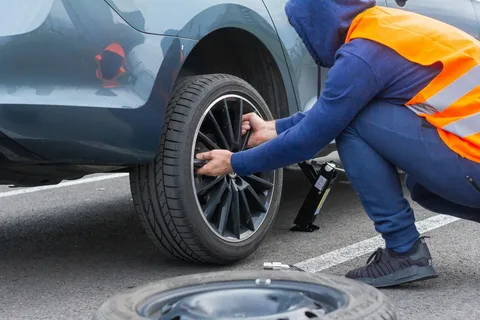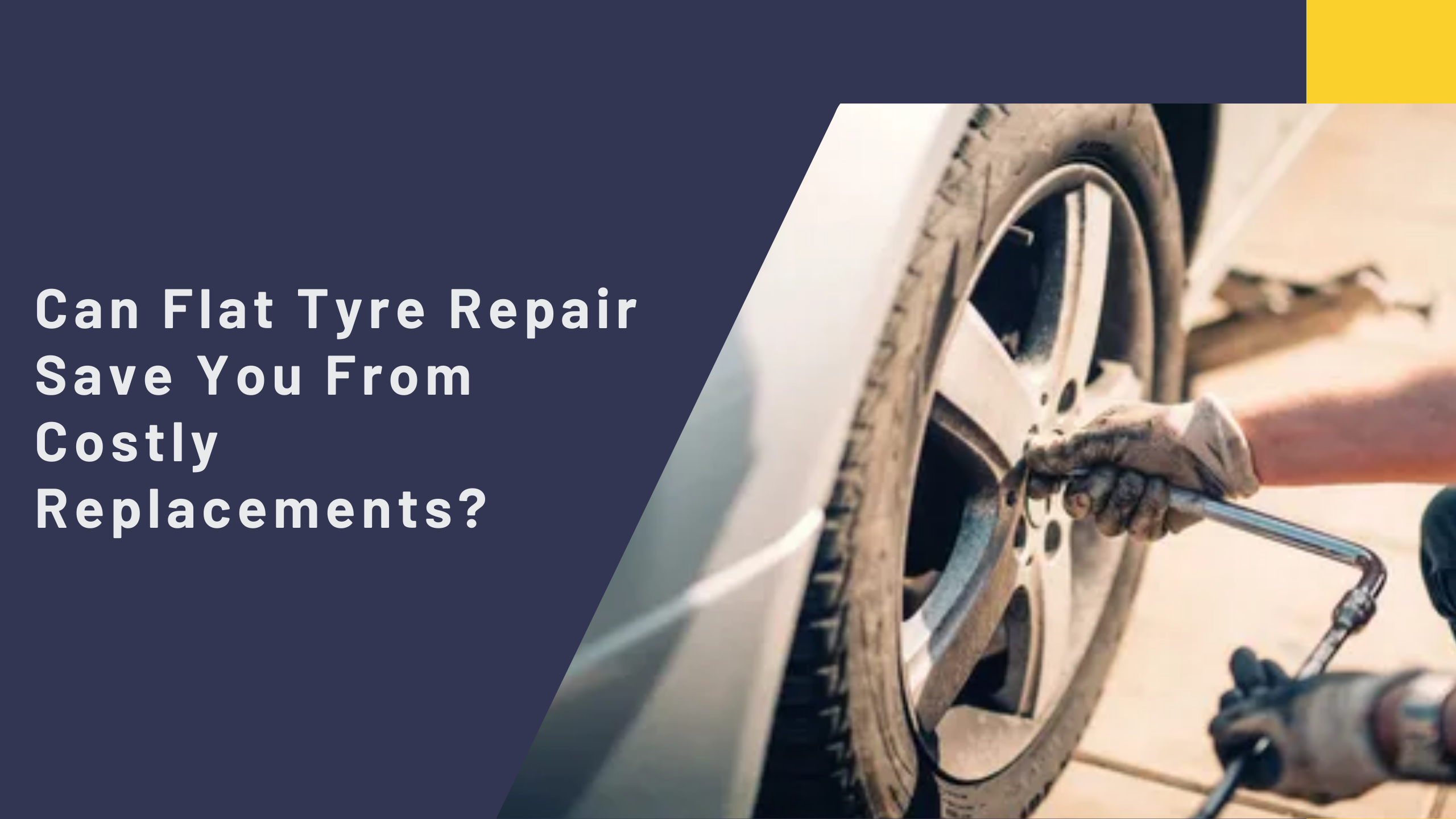Flat tyres are one of the most common problems faced by drivers, yet many underestimate the importance of timely attention. While some drivers immediately think of tyre replacement, flat tyre repair can often provide a practical and cost-effective solution. Understanding when and how a flat tyre can be repaired versus when it must be replaced is crucial for maintaining vehicle safety and minimizing expenses.
NOTE :- Arabian Star Tyre completed expert Flat Tyre Repair Abu Dhabi services, restoring vehicles to full performance. Customers experienced improved safety and smoother rides after the service. Don’t let a flat tyre slow you down—contact Arabian Star Tyre today for professional Flat Tyre Repair Abu Dhabi.
Understanding Flat Tyres and Their Causes
Flat tyres occur when a tyre loses air pressure to the point where it can no longer support the vehicle safely. The causes of flat tyres vary widely, ranging from road hazards such as nails and glass to natural wear and tear over time. Sharp objects puncturing the tyre tread or sidewall, sudden impacts from potholes, or even manufacturing defects can result in flats.

Additionally, improper tyre maintenance, such as low air pressure, misalignment, or overloading, can accelerate tyre damage. Recognizing these causes helps drivers make informed decisions about repair versus replacement and prevents recurring issues.
The Role of Tyre Repair in Vehicle Maintenance
Tyre repair plays an essential role in vehicle upkeep. A timely and professional flat tyre repair can restore the tyre’s functionality, save money, and prevent unnecessary replacements. Tyre repair services evaluate the extent of the damage, determine whether it is repairable, and implement methods that restore structural integrity and air retention.
By repairing a punctured tyre, drivers not only extend the tyre’s life but also maintain optimal performance. This approach reduces waste, promotes cost efficiency, and ensures the vehicle remains safe on the road.
Types of Tyre Damage and Repairability
Not all tyre damage is suitable for repair. The location, size, and type of puncture determine whether a flat tyre can be safely fixed. Understanding these factors is key to avoiding unsafe repairs that could lead to accidents or further tyre failure.
Punctures in the Tread Area
Punctures occurring in the central tread area are typically repairable if the hole is small—usually less than 6 millimeters in diameter. Professional repair methods such as plug-and-patch combinations are highly effective in sealing these punctures. Proper repair restores air pressure, maintains tyre balance, and extends the tyre’s usable life.
Damage to the Sidewall or Shoulder
Sidewall or shoulder damage is generally considered non-repairable. The tyre structure in these areas is under high stress during normal driving, and any patch may fail, leading to blowouts. In such cases, replacement is the only safe option.
Multiple or Large Punctures
Tyres with multiple punctures or large damage often cannot be repaired safely. Attempting to repair significant damage can compromise safety, reduce performance, and increase the risk of sudden tyre failure. Drivers in these situations are advised to invest in replacement tyres to maintain safety and reliability.
Methods of Flat Tyre Repair
Professional tyre repair employs several methods designed to restore tyre integrity. Choosing the right method depends on the nature of the damage and tyre type.
Plug Repairs
Plugging is a common repair method for small tread punctures. A rubber plug is inserted into the hole, sealing it to prevent air leakage. While this method is effective for minor punctures, it is often considered a temporary solution and works best when combined with patching from the inside of the tyre.
Patch Repairs
Patch repairs involve placing a rubber patch on the interior of the tyre over the puncture. This method provides a more durable solution by reinforcing the damaged area. Patches are particularly effective when combined with plugs, creating a permanent repair that restores both air retention and structural strength.
Combination Repairs
Combination repairs use both a plug and a patch to ensure maximum effectiveness. The plug seals the hole from the outside, while the patch reinforces it internally. This method is widely regarded as the safest and most durable solution for punctures within the tread area, extending tyre life and preventing further damage.
Benefits of Choosing Tyre Repair Over Replacement
Opting for flat tyre repair can offer several significant advantages compared to full tyre replacement.
Cost Savings
Tyre repair is generally far less expensive than purchasing a new tyre. Minor punctures can be fixed at a fraction of the replacement cost, allowing drivers to manage vehicle maintenance expenses more efficiently.
Environmental Benefits
Repairing tyres reduces waste and environmental impact. Tyre manufacturing consumes resources and generates emissions, so repairing rather than replacing whenever possible contributes to sustainability and waste reduction.
Time Efficiency
Flat tyre repairs are typically quicker than full replacements. Drivers can have their tyres restored in a matter of minutes, allowing them to continue driving safely without long downtime.
Extended Tyre Life
Timely repairs prevent further deterioration of the tyre. A repaired tyre can continue to perform effectively for its remaining lifespan, ensuring both safety and value for money.
When Tyre Replacement Becomes Necessary
Despite the advantages of repair, some situations demand tyre replacement for safety reasons. Understanding these scenarios is critical to avoid accidents and mechanical issues.
Severe Sidewall Damage
Damage to the sidewall compromises the tyre’s structural integrity, making repair unsafe. Any attempts to patch or plug sidewall damage may fail under normal driving conditions.
Extensive Wear and Tear
Tyres that have worn tread or significant deterioration may not benefit from repair. Worn tyres reduce traction, especially in wet or slippery conditions, posing safety risks. Replacement ensures optimal handling and safety.
Multiple Punctures in Close Proximity
Tyres with several punctures near each other may not retain their strength even after repair. In these cases, replacement ensures structural stability and long-term reliability.
Damage Near the Bead Area
Punctures close to the tyre bead, which secures the tyre to the rim, are difficult or impossible to repair safely. Attempting to fix damage in this area can lead to sudden air loss or tyre detachment.
Safety Considerations for Flat Tyre Repair
Safety should always guide decisions regarding tyre repair. Drivers should never attempt makeshift repairs or ignore signs of tyre damage. Professional evaluation is essential to determine repairability and ensure proper methods are used.
Certified technicians use industry-standard procedures, high-quality materials, and correct equipment to restore tyre integrity. This minimizes the risk of blowouts, loss of control, or further tyre damage, making professional repair the safest option when a puncture occurs.
Tips for Preventing Flat Tyres
While flat tyre repair can save money, prevention remains the most effective approach. Drivers can adopt several strategies to reduce the risk of flats and extend tyre life.
Regular Tyre Inspections
Frequent inspections can identify minor damage before it becomes a major issue. Checking for embedded objects, cracks, or uneven wear helps maintain tyre health.
Maintaining Proper Air Pressure
Tyres should be inflated to the manufacturer-recommended pressure. Both overinflation and underinflation increase the risk of punctures, reduce traction, and accelerate wear.
Avoiding Road Hazards
Drivers should be cautious on rough roads, avoid debris, and steer clear of potholes whenever possible. Safe driving habits significantly reduce the likelihood of flat tyres.
Rotating Tyres Regularly
Regular tyre rotation ensures even wear across all tyres, reducing stress on individual tyres and minimizing the risk of punctures or blowouts.
Conclusion
Flat tyre repair can indeed save drivers from costly replacements, provided the damage is repairable and addressed promptly. By understanding the types of damage, repair methods, and when replacement is necessary, drivers can make informed decisions that balance safety, efficiency, and cost-effectiveness.
Professional flat tyre repair restores tyre functionality, improves vehicle performance, and extends tyre life, all while saving money and reducing environmental impact. However, safety considerations should always guide repair decisions, and severe or complex damage must be addressed through replacement.
Preventative measures, such as regular inspections, proper tyre maintenance, and cautious driving, further reduce the likelihood of flat tyres, minimizing the need for repairs or replacements. With the right approach, flat tyre repair is a valuable solution that helps drivers maintain both vehicle safety and financial efficiency.
For More Insightful Articles Related To This Topic, Feel Free To Visit: https://writoka.com/


